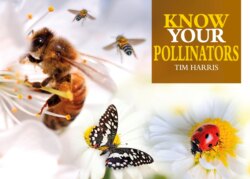Читать книгу Know Your Pollinators - Tim Harris - Страница 7
На сайте Литреса книга снята с продажи.
1 Buff-tailed Bumblebee Bombus terrestris
ОглавлениеCharacteristics
Length: Queen 0.71 in (18 mm); worker and male 0.51–0.55 in (13–14 mm).
Flight season: May–October.
Nectar sources: Very varied.
Habitat: Meadows, farmland, parks, gardens.
The large, furry, European bumblebee is a familiar sight as it forages on garden flowers. It can be identified by two orange “collars” on a black background, one near the neck and one on the abdomen. The tip of the abdomen is buff in queens and males, but whitish in workers.
After emerging from hibernation in spring, a queen will start foraging busily on flowers such as sallows, plums, cherries, and gorse—and she will pick an underground site for a new colony, often an old mouse nest. Once settled, she lays eggs, which hatch into larvae. When it reaches its peak, there may be more than 500 bees in a colony, most of them workers (all females), which perform most of its important functions: foraging for food at flowers as varied as knapweeds, daisies, lavender, deadnettles, and ivy, according to the season. The workers also defend the nest from attackers and care for the larvae. Male bees, or drones, hatch from unfertilized eggs; they leave the colony when they reach adulthood to go in search of a mate, their only function.
